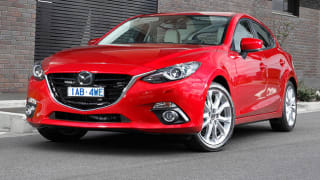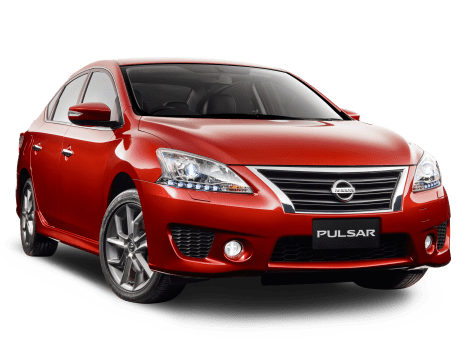
Mazda 3 SP25 2014 Review
New Mazda 3 is a cracking good car. Way better than the super popular previous model -- and around the same money.
Browse over 9,000 car reviews
A feeling of warmth pervades the very middle of the small car class. Barely discernible at the year's outset, the sensation spreads slowly but surely.
We speak of the warm hatch - a sub-species to be found pretty much at the mid-point between the $19K economy five-door and the $40K hottie, a la Volkswagen's Golf GTI. As yet there's not a lot of competition in this league - the three you see under “rivals” are almost the field - but the return of a badge to which boy racers once aspired is a sure sign that the game's afoot in the middle ground.
The SSS is, for those of a certain age, synonymous with a hatch less ordinary. Discontinued in 2001, it was the model that informed then big-car-loving ‘Strayans that a small car could come with a satisfying serving of performance and a soupcon of fun without being a Subaru Impreza.

It's to the middle way that the revived SSS returns, with a slightly lesser ST-S variant to keep the price nicer.
Nissan's new hatch range starts from a cheeky $18,990 for the ST manual, a symbolic but meaningless $500 under the far better equipped entry Cruze.
ST-S is a new model name, one that includes all the bits found in the mid-grade ST-L but with the turbo engine of the SSS. At $24,490, this is in almost every respect a direct rival for the Cruze SRi, with the expected step above entry kit including front fog lights, rear spoiler, small colour display plus 17-inch alloys and auto adds $2500.
From $29,240, the SSS cops intelligent xenon lights, front spoiler and skirts, bigger screen with satnav, rear-view camera with distance guidelines, leather trim and keyless entry and go. This is a shade north of the SRi-V version of the Cruze but the latter lacks satnav, so the triple-S makes the running in this still new terrain.
Direct fuel injected four-cylinder turbo petrol engines are de rigueur in European cars, driven by the push to lower emissions. It's been long acknowledged in that part of the planet that a 1.6 or even 1.4 turbo engine can out pull a much bigger and heavier naturally aspirated engine while returning far superior economy.
It's a rule that applies beyond affordable small cars. The entire engine line-up of BMW consists of direct injected turbo engines. Take the humble Falcon (please - someone take it): the four-cylinder direct injection Ecoboost loses nothing in performance to the ancient straight six while sipping and emitting far less. Yet among Japan’s makers, Nissan is almost alone in grasping let alone implementing this.
This example of the species puts out a nice 140kW/240Nm, placing it firmly in the thick of the warm hatch milieu. Naturally a six-speed manual is the standard transmission but the Pulsar's auto option - uniquely in this sub-segment - is a continuously variable jobbie with manual presets.
The Pulsar sedan, released earlier this year, is among the better selling small cars. You could be forgiven for being unaware of this, so utterly anonymous is its design. Possibly there have been cars of less inspiring appearance but the Nissan four-door is nigh on invisible.
The hatchback, of which two milder versions are released this week in addition to the turbo twins, is going to be easier to find in a crowded carpark.
It's very much of the moment stylised lights, sharp creases and high sill line, which does little for the little ones who want to see out of the back.
That incremental price increase between grades - some $5000 between ST-S and SSS - is fair enough given the step up in quality. Still, this is no Audi, nor even a Golf - though at the moment that could be a good thing.
But seriously, folks, you might get leather and bigger satnav screen in the SSS but you're not unaware that this is (like the Cruze SRi-V) a mildly embellished econo-car. Yet there's plenty of air in there. As it stands a smidge taller than most small cars, grown-ups won't hate being in the back.
Pulsar's sedan was smashed into the wall by ANCAP earlier this year, earning the maximum five-star rating. The local crash test authority made particular mention of advanced seat belt reminders fitted to the front seats.
“In the frontal offset crash test,” it found, “driver chest protection was acceptable and upper leg protection was marginal. Passenger chest and leg protection was acceptable. In the side impact crash test, driver chest protection was acceptable. Head protection in the side pole test was good.”
So there you are.
The legend grown in the telling? Or was it not much of a yarn in the first place? Who can remember? And who, today, cares?
Suffice that on the road, the story of the resurrected SSS has been adapted for our times, a narrative of urban utility and family friendliness enlivened by a spicy B-road subplot.
You can't say this otherwise worthy but unremarkable Thai-built small car has been transformed per se but it's certainly been enhanced. A modicum of suspension and damper tautening, and no more than that, abets a talented little engine that delivers torque almost immediately north of idle and keeps it coming hot and strong.
This engine works in the city, where the need to work the manual shifter is largely removed, as well as on amusing stretches of road, where it nevertheless revs cleanly to 6000rpm without protest.
It would have been informative to sample the CVT/turbo combo (none was available so we'll bring that to you soon) but for once it's not merely an auto hack's indulgence to extol a manual. Yes, fewer of you want to swap cogs for yourself, but if ever you've derived satisfaction from this simple but fulfilling act here's a manual well worth trying. A silken shift marries happily with this clutch's progressive take-up.
Again though, this is about a nice warm feeling rather than stove hotness, and the SSS's notable body roll and comparative softness serve to arrest back-road banditry. These characteristics would be grievous faults in a GTI or Focus ST yet they serve here to inform the drive and make tolerable the ride.
An unusually spacious car for its type seems to shrink around you when driven with intent, a neat trick and just the double act required. Lesser in terms of kit and price, the ST-S loses nothing on the road. The Cruzes against which these Pulsars are positioned are that bit more adept and can be optioned with one of best six-speed autos around. The comparison awaits.
You need no longer drop $40K for a fun-to-drive small car. The SSS and sibling confirm the arrival of the warm hatch, the car that comes in a family-sized serving with individual satisfaction.
| Vehicle | Specs | Price* | |
|---|---|---|---|
| ST-L | 1.8L, —, 6 SP MAN | $6,930 – 9,790 | 2013 Nissan Pulsar 2013 ST-L Pricing and Specs |
| ST | 1.8L, —, CVT AUTO | $7,480 – 10,560 | 2013 Nissan Pulsar 2013 ST Pricing and Specs |
| ST-S | 1.6L, —, 6 SP MAN | $7,810 – 11,000 | 2013 Nissan Pulsar 2013 ST-S Pricing and Specs |
| ST | 1.8L, —, 6 SP MAN | $6,930 – 9,790 | 2013 Nissan Pulsar 2013 ST Pricing and Specs |
$3,800
Lowest price, based on 124 car listings in the last 6 months